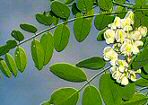Black Locust
 Black
Locust (Robinia pseudoacacia /Fabaceae). The
genus Robinia contains approximately 10 species that grow naturally
in eastern North Black
Locust (Robinia pseudoacacia /Fabaceae). The
genus Robinia contains approximately 10 species that grow naturally
in eastern North  America
and Mexico. Robinia pseudoacacia grows from the Appalachian Mountains
in Pennsylvania south to northern Georgia to eastern Oklahoma.
Robinia pseudoacacia trees reach heights of 100 ft with diameters
of 3 ft. Robinia pseudoacacia sapwood is off-white and the heartwood
color can be a greenish yellow to a deep dark red brown. The wood
of Robinia pseudoacacia is very dense and brittle with a strong
decay resistance. Black locust is extremely strong and hard, like
Hickory, but is hard to work with hand tools. It is used in fencing,
furniture, insulator pins, long bows, mine timbers, and treenails
for ships. America
and Mexico. Robinia pseudoacacia grows from the Appalachian Mountains
in Pennsylvania south to northern Georgia to eastern Oklahoma.
Robinia pseudoacacia trees reach heights of 100 ft with diameters
of 3 ft. Robinia pseudoacacia sapwood is off-white and the heartwood
color can be a greenish yellow to a deep dark red brown. The wood
of Robinia pseudoacacia is very dense and brittle with a strong
decay resistance. Black locust is extremely strong and hard, like
Hickory, but is hard to work with hand tools. It is used in fencing,
furniture, insulator pins, long bows, mine timbers, and treenails
for ships.
http://www.fpl.fs.fed.us/documnts/TechSheets/HardwoodNA/pdf_files/robpseudeng.pdf.
Characteristics found in the Locust, Black (Robinia
pseudoacacia)
- Ring porous
- Coalesced/Confluent parenchyma
- Tyloses
- Spirals in vessels
- Simple perforations
- I/V pits medium (8-12)
- Rays 1-8 seriate & homocellular to heterocellular
- Crystals in rays and axial parenchyma
WOOD SLIDES
Click on each image to view a larger
image.
   
   
 
CHARCOAL SLIDES
   
  
|



 Black
Locust (Robinia pseudoacacia /Fabaceae). The
genus Robinia contains approximately 10 species that grow naturally
in eastern North
Black
Locust (Robinia pseudoacacia /Fabaceae). The
genus Robinia contains approximately 10 species that grow naturally
in eastern North  America
and Mexico. Robinia pseudoacacia grows from the Appalachian Mountains
in Pennsylvania south to northern Georgia to eastern Oklahoma.
Robinia pseudoacacia trees reach heights of 100 ft with diameters
of 3 ft. Robinia pseudoacacia sapwood is off-white and the heartwood
color can be a greenish yellow to a deep dark red brown. The wood
of Robinia pseudoacacia is very dense and brittle with a strong
decay resistance. Black locust is extremely strong and hard, like
Hickory, but is hard to work with hand tools. It is used in fencing,
furniture, insulator pins, long bows, mine timbers, and treenails
for ships.
America
and Mexico. Robinia pseudoacacia grows from the Appalachian Mountains
in Pennsylvania south to northern Georgia to eastern Oklahoma.
Robinia pseudoacacia trees reach heights of 100 ft with diameters
of 3 ft. Robinia pseudoacacia sapwood is off-white and the heartwood
color can be a greenish yellow to a deep dark red brown. The wood
of Robinia pseudoacacia is very dense and brittle with a strong
decay resistance. Black locust is extremely strong and hard, like
Hickory, but is hard to work with hand tools. It is used in fencing,
furniture, insulator pins, long bows, mine timbers, and treenails
for ships.















